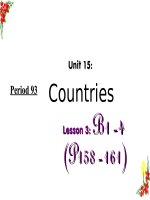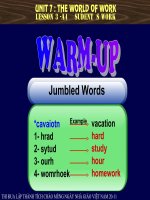Anh 6: Unit 1: Lesson 3: A closer look 2
Bạn đang xem bản rút gọn của tài liệu. Xem và tải ngay bản đầy đủ của tài liệu tại đây (112.32 KB, 8 trang )
<span class='text_page_counter'>(1)</span><div class='page_container' data-page=1>
<b>Date of preparing: Period: 3 </b>
<b>UNIT 1: MY NEW SCHOOL</b>
<b> LESSON 3: A CLOSER LOOK 2 ( P. 9 )</b>
<b>A. OBJECTIVES: </b>
- By the end of this lesson, students will be able to understand more about the
present simple and the present continuous by doing some tasks.
+ Vocabulary:
+ Grammar: The present simple and the present continuous.
- Skills: Practice and develope speaking and writing skills .
- Political thought and moral sence: Educate students to love their new school and
they will be interested in learning English more.
<b>B. OBJECTIVES: .</b>
- Textbook, teacher’s book, lesson plan, board, chalks, pictures, posters, stereo and
the CD record.
<b>C. TEACHING AIDS: </b>
Matching, gap - fill, role - play, wordcue - drill, multiple - choice.
<b>D. CONTENTS:</b>
<b>I .Oganization: </b>
<b>Class</b> <b>Date of teaching</b> <b>Absent students</b>
<b>6A8</b>
<b>II. Revision / Warmer: </b>
<i><b>*Matching</b></i>
- T hangs the poster on the board then runs through.
<b>A</b> <b>B</b>
1. playground
2. walk
3. ride (our) bike
4. break time
5. library
</div>
<span class='text_page_counter'>(2)</span><div class='page_container' data-page=2>
6. homework f. giờ giải lao
- T gives the instructions: You match one English word in column A with its
meaning in column B.
- T models the first one. 1 - d.
- T checks Ss' understanding.
- Ss prepare in one minute.
- T gets Ss' answers by dividing the class into 2 groups. T gives names -> checks
names.
- T controls, corrects, gives marks, praises the winner.
<i><b>+ Answer keys.</b></i>
<b> 1- d; 2 - e; 3 - b; 4 - f; 5 - a; 6 - c. </b>
<b>III. New lesson:</b>
<i><b>Step1: Activity 1: The present simple.</b></i>
<i><b>* Gap - fill.</b></i>
- T asks Ss to look at their book part 1 on page 9.
- T shows the dialogue and sets the scene: Miss Nguyet is interviewing Duy for
school newsletter.
- T runs though.
- T gives the instructions: Write the correct form of the verbs.
- T models one.
1. has.
- T checks Ss’ understanding.
- Ss do individually then compare with their partners.
- T Gets Ss’ answers by dividing the class into 2 groups. Each student from each
group can write one answer.
- T controls, corrects, gives marks then praises the winner.
<i><b>+ Answer key:</b></i>
</div>
<span class='text_page_counter'>(3)</span><div class='page_container' data-page=3>
4. Does Vy walk 9. go
5. ride 10. do
<i><b>* Role - play.</b></i>
- T asks two students to read again the dialogue. One student is Miss Nguyet, one
student is Duy.
- T asks other students to give comments.
- T corrects.
<i><b>* Correcting the sentences.</b></i>
- T hangs the poster on the board.
0) Duy’s new school has a small playground.
1. Duy doesn’t live near here.
2. Duy doesn’t like his new school.
3. Vy and Duy walk to school.
4. Mr Quang teaches Duy science.
5. At break time, Phong play football.
- T runs through the poster.
- T gives the instructions: Read again the dialogue then correct the sentences.
- T models the first one.
0) Duy’s new school has a small playground.
-> Duy’s new school has a large playground.
- T checks Ss’ understanding.
- Ss do the task individually then they compare with their partners.
- T asks one by one student to correct.
- T corrects.
<i><b>+ Answer key:</b></i>
1. Duy lives near here.
</div>
<span class='text_page_counter'>(4)</span><div class='page_container' data-page=4>
5. At break time, Phong reads in the library.
- T asks Ss to give the rule and use of the present simple themselves.
- T asks Ss to look at “ Remember” in the textbook P. 14 then explain to them.
Positive: I / you / we / they + V ( work / study )
He / she / it + V-s / V-es ( works / studies )
Negative: I / you / we / they + don’t / do not + V ( don’t / do not work / study )
He / she / it + doesn’t / does not + V ( doesn’t / does not work / study )
Questions and short answers :
Do + I / you / we / they + V ( work / study )?
Yes, I / you / we / they do.
No, I / you / we / they don’t.
Does + He / she / it + V ( work / study )?
Yes, he / she / it does.
No, he / she / it doesn’t.
<i><b> * Wordcue - drill.</b></i>
- T shows out some word cues then T runs through .
a. you / ride your bicycle / to school
b. you / read / in the library / at break time
c. you / like / your new school
d . your friends / go to school / with you
</div>
<span class='text_page_counter'>(5)</span><div class='page_container' data-page=5>
- Tgives the instruction : Use the structure above and the suggested words to
make questions and answer for each part .
- T models one : a. Do you ride your bicycle to school?
Yes, I do / No, I don’t.
- T chcks Ss’ understanding.
- Ss do in choral.
- T - WC / Half - Half / Open pairs.
- T corrects ss' mistakes (if wrong )
<i><b>+ Answer key: </b></i>
b. Do you read in the library at break time?
Yes, I do / No, I don’t.
c. Do you like your new school?
Yes, I do / No, I don’t.
d . Do your friends go to school with you?
Yes, I do / No, I don’t.
e . you / do your homework / after school
Yes, I do / No, I don’t.
<i><b>Step2: Activity 2: The present continuous.</b></i>
- T shows the dialogue on the board.
Phong: Oh, someone’s knocking at the door.
Phong’s Mum: Hi Vy, you’re early! Phong’s having breakfast.
- T turns on the tape twice.
- Ss listen to the tape and underline the present continuous form:
Phong: Oh, someone’s knocking at the door.
Phong’s Mum: Hi Vy, you’re early! Phong’s having breakfast
- T shows the grammar box then explains how the present continuous is formed
and used.
</div>
<span class='text_page_counter'>(6)</span><div class='page_container' data-page=6>
You / we / they are + V-ing ( studying )
He / she / it is
Negative:
I am
You / we / they are + not V-ing ( not studying )
He / she / it is
Questions and short answers :
Am I
Are you / we / they + V-ing ?
Is he / she / it
Yes, you / we / they are.
he / she / it is.
No, you / we / they aren’t.
he / she / it isn’t.
<i><b>*Complete the sentences.</b></i>
- T hangs a poster on the board with some uncompleted statements.
0. Yummy! I ( have ) ... school lunch with my new friends.
1. I ( not play) ... football now. I’m tired.
2. Shh! They ( study ) ... in the library.
3. Vy and Phong ( not do ) ... their homework.
</div>
<span class='text_page_counter'>(7)</span><div class='page_container' data-page=7>
- T goes through
- T asks Ss to give the correct form of the verbs.
- T models : 0) am having.
- T checks understandings.
- T asks Ss to do individually then they compare with their partners.
- T divides the class into groups -> Names -> Checks.
- Ss from two groups come to the board and write the answers. One student can
write one only.
- T controls, gives marks then praises the winner.
<i><b>+ Answer key:</b></i>
1. am not playing
2. are studying
3. are not doing
4. am having
5. are riding.
<i><b>Step3: Activity 3: Production.</b></i>
<i><b>* Multiple choice.</b></i>
- T shows the poster on the board.
<i>1. My family have / are having dinner now.</i>
<i>2. Mai wears / is wearing her uniform on Mondays and Saturdáy.</i>
<i>3. The school year in Viet Nam starts / is starting on Sep 5th.</i>
<i>4. Now Duong watches / is watching Ice Age on video.</i>
<i>5. Look! The girls skip / are skipping in the schoolyard.</i>
- T runs through the poster.
- T gives the instructions: Choose the correct tense of the verbs.
- T models the first one.
1. are having
</div>
<span class='text_page_counter'>(8)</span><div class='page_container' data-page=8>
- T gives indirect correction.
<i><b>+ Answer key:</b></i>
2. wears
3. starts
4. is watching
5. are skipping
<b>IV. Summary: </b>
- T asks ss to repeat the main contents of the lesson: The present simple and the
present continuous.
<b>V. Homework:</b>
- Learn by heart the form of the present simple and the present continuous.
- Finish part 8 P. 10. Underline things that often happen or fixed / things that are
happening now.
- Do the exercise in your workbook: Ex 4, 5, 6 P. 5
- Prepare the new lesson: Unit 1: Lesson 4: Communication
<b>E.EVALUATION: </b>
</div>
<!--links-->









